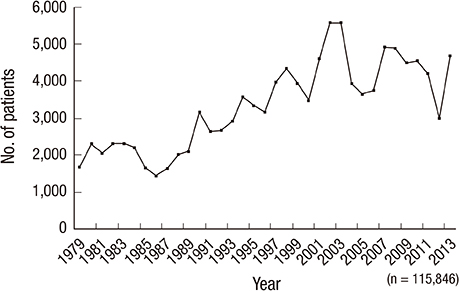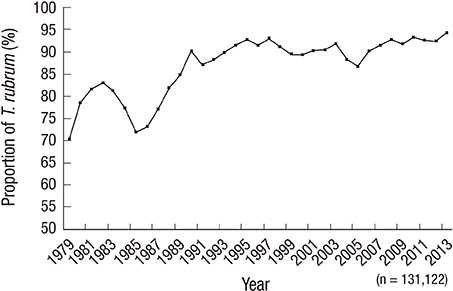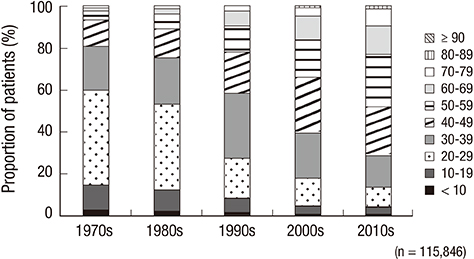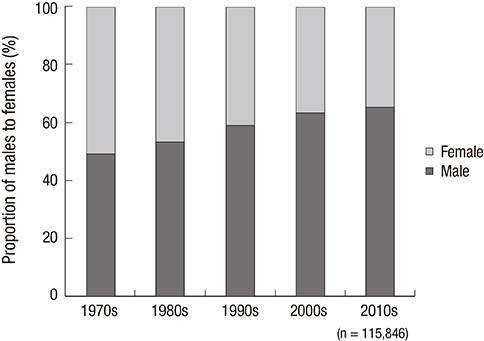Increasing Prevalence of Trichophyton rubrum Identified through an Analysis of 115,846 Cases over the Last 37 Years
- Affiliations
-
- 1Department of Dermatology, Kyungpook National University School of Medicine, Daegu, Korea. weonju@knu.ac.kr
- 2Institute of Medical Mycology, Catholic Skin Clinic, Daegu, Korea.
- KMID: 2155479
- DOI: http://doi.org/10.3346/jkms.2015.30.5.639
Abstract
- Trichophyton rubrum is the most common dermatophyte in the world with the highest prevalence in Korea. There are few reports about epidemiological and mycological characteristics of T. rubrum based on long-term, large-scale studies. The purpose of this study was to investigate the clinical and epidemiological characteristics of T. rubrum infections in Korea. We retrospectively investigated with patients' records about the epidemiological and mycological status of 115,846 cases with T. rubrum infection that was mycologically diagnosed at Catholic Skin Disease Clinic from 1979 to 2013. Direct microscopy in 15% KOH solution and culture was done in each case. The annual incidence of patients with T. rubrum infection had been increasing during the period; and of 131,122 patients with dermatophytosis, 115,846 patients (88.35%) had T. rubrum infection. Disease was most prevalent among patients in their twenties in the 1970s and 1980s; in their thirties in the 1990s; in their forties in the 2000s; and in their fifties in the 2010s. The sex ratio was 1.5:1. T. rubrum infection was most commonly seen in summer and was found predominantly in patients living in urban areas. Toe webs were most frequently involved, followed by toenails and groin. This epidemiologic findings provide useful information for prevention of T. rubrum infection and future dermatophytosis prospects.
Keyword
MeSH Terms
Figure
Cited by 3 articles
-
The Epidemiology of Dermatophyte Infection in Southeastern Korea (1979~2013)
Sang Lim Kim, Kyou Chae Lee, Yong Hyun Jang, Seok-Jong Lee, Do Won Kim, Weon Ju Lee, Yong Jun Bang, Jae Bok Jun
Ann Dermatol. 2016;28(4):524-527. doi: 10.5021/ad.2016.28.4.524.Low But Continuous Occurrence of
Microsporum gypseum Infection in the Study on 198 Cases in South Korea from 1979 to 2016
Weon Ju Lee, Jun Hong Park, Jun Young Kim, Yong Hyun Jang, Seok-Jong Lee, Yong Jun Bang, Jae Bok Jun
Ann Dermatol. 2018;30(4):427-431. doi: 10.5021/ad.2018.30.4.427.Analysis of Adult Patients with Tinea Capitis in Southeastern Korea
Hyun Ji Lee, Jun Young Kim, Kyung Duck Park, Yong Hyun Jang, Seok-Jong Lee, Yong Jun Bang, Jae Bok Jun, Weon Ju Lee
Ann Dermatol. 2020;32(2):109-114. doi: 10.5021/ad.2020.32.2.109.
Reference
-
1. Havlickova B, Czaika VA, Friedrich M. Epidemiological trends in skin mycoses worldwide. Mycoses. 2008; 51:2–15.2. Kim HS. The statistical and mycological survey on superficial dermatomycoses. Korean J Dermatol. 1971; 9:1–4.3. Rhim KJ, Kim JH, Shin S. A clinical and mycological study of superficial dermatophytoses. Korean J Dermatol. 1978; 16:435–442.4. Min BK, Chung BS, Choi KC, Kim HK. Clinical and mycological studies on dermatophytosis. Korean J Dermatol. 1984; 22:604–609.5. Lee HK, Seo SJ, Kim MN, Hong CK, Ro BI. A clinical and mycological study of superficial fungal diseases(vii). Korean J Dermatol. 1993; 31:559–566.6. Moon HJ, Lee JB, Kim SJ, Lee SC, Won YH. Clinical and mycological studies on dermatomycosis (1991-2000). Korean J Med Mycol. 2002; 7:78–85.7. Lee DK, Moon KC, Koh JK. Clinical and mycological studies on superficial fungal infection. Korean J Med Mycol. 2006; 11:54–63.8. Lee YW, Yun SJ, Lee JB, Kim SJ, Lee SC, Won YH. Clinical and mycological studies on dermatomycosis (2001-2010). Korean J Med Mycol. 2013; 18:30–38.9. Kim BS, Suh SB. Mycological and clinical observation on dermatophytosis. Korean J Dermatol. 1976; 14:325–334.10. Suh SB, Kim SW, Oh SH, Choi SK, Bang YJ. A case of block dot ringworm caused by Trichophyton tonsurans. Korean J Dermatol. 1998; 36:918–923.11. Sung SY, Kim HY, Kim HU, Ihm CW. Trichophyton tonsurans infection in Wrestlers and a child. Korean J Dermatol. 1998; 36:732–736.12. Kim JC, Choi JS, Kim KH, Suh SB. Mycological features of Trichophyton verrucosum isolated in Taegu area. Korean J Dermatol. 1992; 30:761–768.13. Kim YP, Chun IK, Kim SH. A case of kerion celsi caused by Trichophyton verrucosum and its epidemiologic study. Korean J Dermatol. 1986; 24:687–691.14. Jun JB, Suh SB. Clinical and mycological studies on microsporum gypseum infection. Korean J Dermatol. 1980; 18:369–381.15. Lee DS, Cho GY, Kim YH, Houh W. A case of tinea capitis due to microsporum gypseum. Korean J Dermatol. 1984; 22:643–646.16. Lee H, Lee ES, Kang WH, Lee SN. An unusual clinical manifestation of tinea corporis caused by microsporum ferrugineum. Korean J Dermatol. 1987; 25:383–388.17. Kim HU, Choi CJ, Yun SK. Three cases of tinea capitis caused by microsporum ferrugineum. Korean J Dermatol. 1993; 31:760–764.18. Kim YA, Lee KH, Lee JB, Suh SB. A case of fungal granuloma caused by Trichophyton violaceum. Korean J Dermatol. 1989; 27:304–307.19. Lee WJ, Song CH, Lee SJ, Kim do W, Jun JB, Bang YJ. Decreasing prevalence of microsporum canis infection in Korea: through analysis of 944 cases (1993-2009) and review of our previous data (1975-1992). Mycopathologia. 2012; 173:235–239.20. Lee WJ, Park KH, Kim MS, Lee SJ, Kim DW, Bang YJ, Jun JB. Decreasing incidence of Trichophyton mentagrophytes in Korea: analysis of 6,250 cases during the last 21-year-period (1992-2012). J Korean Med Sci. 2014; 29:272–276.21. Seebacher C. The change of dermatophyte spectrum in dermatomycoses. Mycoses. 2003; 46:42–46.22. Seebacher C, Bouchara JP, Mignon B. Updates on the epidemiology of dermatophyte infections. Mycopathologia. 2008; 166:335–352.23. Aly R. Ecology and epidemiology of dermatophyte infections. J Am Acad Dermatol. 1994; 31:S21–S25.24. Scher RK, Rich P, Pariser D, Elewski B. The epidemiology, etiology, and pathophysiology of onychomycosis. Semin Cutan Med Surg. 2013; 32:S2–S4.25. Sigurgeirsson B, Baran R. The prevalence of onychomycosis in the global population - a literature study. J Eur Acad Dermatol Venereol. 2014; 28:1480–1491.26. Katoh T. Dermatomycosis and environment. Nihon Ishinkin Gakkai Zasshi. 2006; 47:63–67.27. Ilkit M, Durdu M. Tinea pedis: the etiology and global epidemiology of a common fungal infection. Crit Rev Microbiol. 2014; doi: 10.3109/1040841X.2013.856853.28. Sei Y. 2006 Epidemiological survey of dermatomycoses in Japan. Med Mycol J. 2012; 53:185–192.29. Tchernev G, Cardoso JC, Ali MM, Patterson JW. Primary onychomycosis with granulomatous tinea faciei. Braz J Infect Dis. 2010; 14:546–547.30. Nenoff P, Mügge C, Herrmann J, Keller U. Tinea faciei incognito due to Trichophyton rubrum as a result of autoinoculation from onychomycosis. Mycoses. 2007; 50:20–25.31. Mirmirani P, Tucker LY. Epidemiologic trends in pediatric tinea capitis: a population-based study from Kaiser Permanente Northern California. J Am Acad Dermatol. 2013; 69:916–921.32. Monod M, Fratti M, Mignon B, Baudraz-Rosselet F. Dermatophytes transmitted by pets and cattle. Rev Med Suisse. 2014; 10:749–753.33. Choe YS, Park BC, Lee WJ, Jun JB, Suh SB, Bang YJ. The clinical observation of Trichophyton verrucosum infections during the last 19 years (1986-2004). Korean J Med Mycol. 2006; 11:45–53.34. Oh SJ, Lee SY, Lee JS. A clinical and mycological study of dermatophytoses in Chungcheongnam-do Province (2008~ 2012). Korean J Med Mycol. 2013; 18:39–47.







